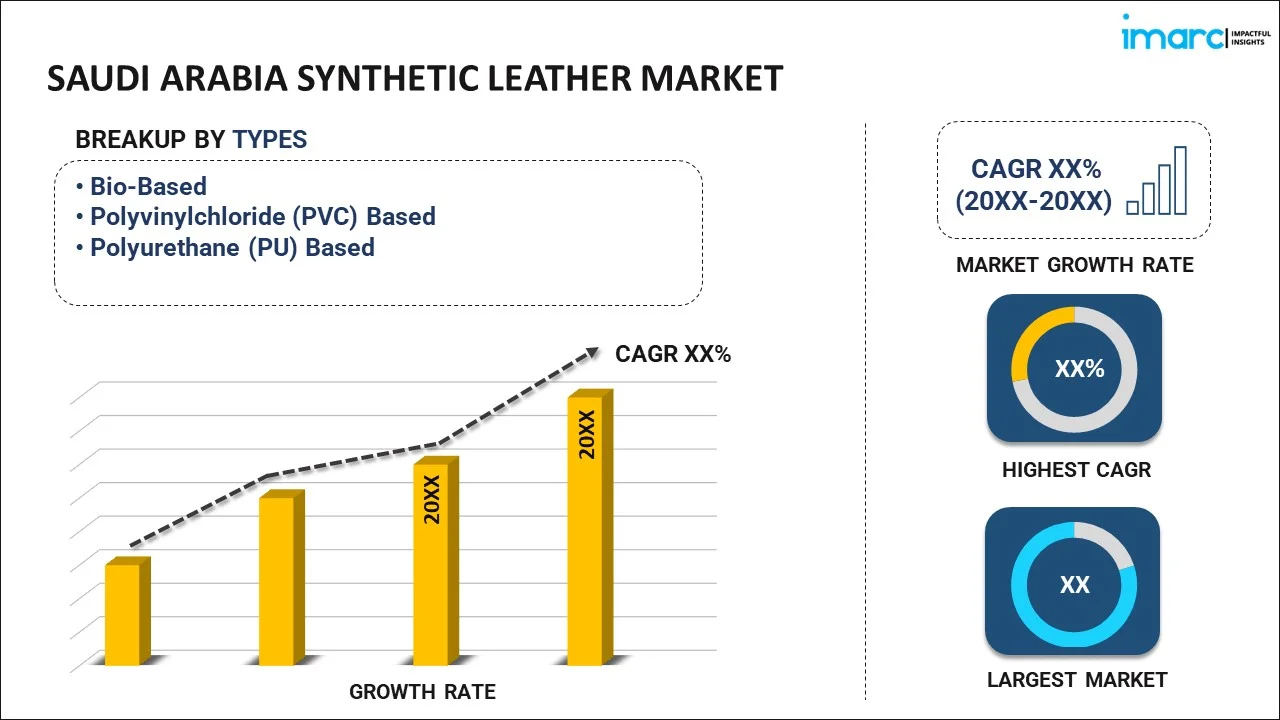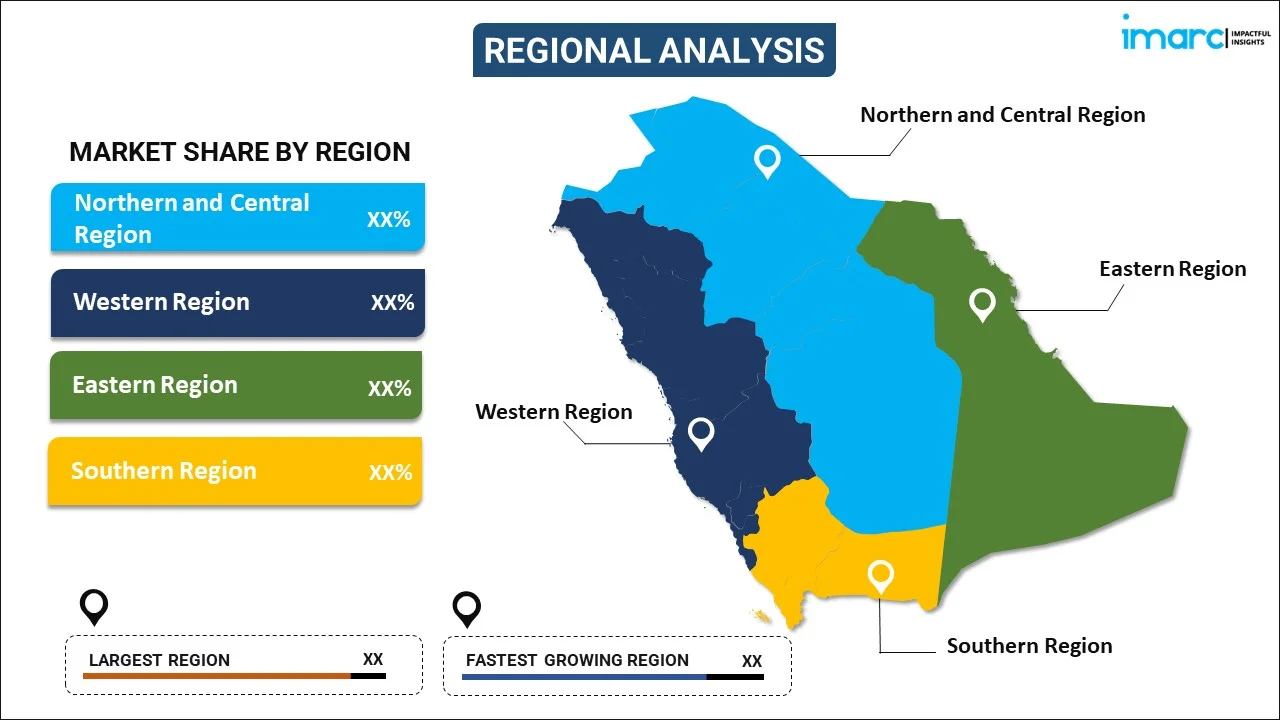
Saudi Arabia Synthetic Leather Market Report by Type (Bio-Based, Polyvinylchloride (PVC) Based, Polyurethane (PU) Based), Application (Clothing, Bags, Shoes, Purses and Wallets, Accessories, Car Interiors, Belts, Sports Goods, and Others), End Use Industry (Footwear, Furniture, Automotive, Textile, Sports, Electronics, and Others), and Region 2024-2032
Market Overview:
Saudi Arabia synthetic leather market size is projected to exhibit a growth rate (CAGR) of XX% during 2024-2032. The increasing advances in material science and technology, which have led to the development of high-quality synthetic leather materials that closely mimic the look and feel of genuine leather, are driving the market.
|
Report Attribute
|
Key Statistics
|
|---|---|
|
Base Year
|
2023 |
|
Forecast Years
|
2024-2032
|
|
Historical Years
|
2018-2023
|
| Market Growth Rate (2024-2032) | XX% |
Synthetic leather, also known as faux leather or imitation leather, is an artificial material designed to replicate the look and feel of genuine leather. Composed of various substances such as polyvinyl chloride (PVC), polyurethane (PU), or a combination of both, synthetic leather is created through a process that involves layering these materials onto a fabric backing. The result is a durable and versatile alternative to natural leather, with the added benefits of being more affordable and easier to maintain. Synthetic leather has gained popularity for ethical and environmental reasons, as it reduces the demand for animal hides and minimizes the environmental impact associated with traditional leather production. Additionally, it allows for a broader range of design possibilities and can be customized to meet specific performance requirements. While not identical to genuine leather, synthetic leather offers a practical and sustainable solution for various industries, including fashion, upholstery, and automotive, meeting the demand for cruelty-free and eco-friendly alternatives.
Saudi Arabia Synthetic Leather Market Trends:
The synthetic leather market in Saudi Arabia is experiencing robust growth, primarily propelled by a surge in consumer demand for sustainable and cruelty-free alternatives. Furthermore, the increasing awareness of environmental concerns and animal welfare issues has driven a notable shift towards synthetic leather products. Additionally, advancements in manufacturing technologies have significantly enhanced the quality and durability of synthetic leather, fostering its acceptance in diverse industries. Moreover, the fashion industry's growing inclination towards sustainable practices has acted as a pivotal driver for the synthetic leather market. Major fashion brands and designers are increasingly incorporating synthetic leather into their product lines, acknowledging its versatility and eco-friendly attributes. This trend is not only reshaping consumer preferences but is also steering the industry toward a more sustainable and ethical future. Furthermore, the automotive sector has emerged as a key contributor to the synthetic leather market's expansion. The demand for high-quality, cost-effective alternatives to traditional leather in automotive interiors has propelled the adoption of synthetic leather materials. This, coupled with the material's resistance to wear and tear, has made it a preferred choice for car manufacturers, driving sustained growth in the synthetic leather market. In essence, the confluence of environmental consciousness, technological innovations, and industry collaborations is steering the regional synthetic leather market toward unprecedented growth and widespread adoption.
Saudi Arabia Synthetic Leather Market Segmentation:
IMARC Group provides an analysis of the key trends in each segment of the market, along with forecasts at the country level for 2024-2032. Our report has categorized the market based on type, application, and end use industry.
Type Insights:

- Bio-Based
- Polyvinylchloride (PVC) Based
- Polyurethane (PU) Based
The report has provided a detailed breakup and analysis of the market based on the type. This includes bio-based, polyvinylchloride (PVC) based, and polyurethane (PU) based.
Application Insights:
- Clothing
- Bags
- Shoes
- Purses and Wallets
- Accessories
- Car Interiors
- Belts
- Sports Goods
- Others
A detailed breakup and analysis of the market based on the application have also been provided in the report. This includes clothing, bags, shoes, purses and wallets, accessories, car interiors, belts, sports goods, and others.
End Use Industry Insights:
- Footwear
- Furniture
- Automotive
- Textile
- Sports
- Electronics
- Others
The report has provided a detailed breakup and analysis of the market based on the end use industry. This includes footwear, furniture, automotive, textile, sports, electronics, and others.
Regional Insights:

- Northern and Central Region
- Western Region
- Eastern Region
- Southern Region
The report has also provided a comprehensive analysis of all the major regional markets, which include Northern and Central Region, Western Region, Eastern Region, and Southern Region.
Competitive Landscape:
The market research report has also provided a comprehensive analysis of the competitive landscape in the market. Competitive analysis such as market structure, key player positioning, top winning strategies, competitive dashboard, and company evaluation quadrant has been covered in the report. Also, detailed profiles of all major companies have been provided.
Saudi Arabia Synthetic Leather Market Report Coverage:
| Report Features | Details |
|---|---|
| Base Year of the Analysis | 2023 |
| Historical Period | 2018-2023 |
| Forecast Period | 2024-2032 |
| Units | US$ Million |
| Scope of the Report | Exploration of Historical Trends and Market Outlook, Industry Catalysts and Challenges, Segment-Wise Historical and Future Market Assessment:
|
| Types Covered | Bio-Based, Polyvinylchloride (PVC) Based, Polyurethane (PU) Based |
| Applications Covered | Clothing, Bags, Shoes, Purses and Wallets, Accessories, Car Interiors, Belts, Sports Goods, Others |
| End Use Industries Covered | Footwear, Furniture, Automotive, Textile, Sports, Electronics, Others |
| Regions Covered | Northern and Central Region, Western Region, Eastern Region, Southern Region |
| Customization Scope | 10% Free Customization |
| Report Price and Purchase Option | Single User License: US$ 3699 Five User License: US$ 4699 Corporate License: US$ 5699 |
| Post-Sale Analyst Support | 10-12 Weeks |
| Delivery Format | PDF and Excel through Email (We can also provide the editable version of the report in PPT/Word format on special request) |
Key Questions Answered in This Report:
- How has the Saudi Arabia synthetic leather market performed so far and how will it perform in the coming years?
- What has been the impact of COVID-19 on the Saudi Arabia synthetic leather market?
- What is the breakup of the Saudi Arabia synthetic leather market on the basis of type?
- What is the breakup of the Saudi Arabia synthetic leather market on the basis of application?
- What is the breakup of the Saudi Arabia synthetic leather market on the basis of end use industry?
- What are the various stages in the value chain of the Saudi Arabia synthetic leather market?
- What are the key driving factors and challenges in the Saudi Arabia synthetic leather?
- What is the structure of the Saudi Arabia synthetic leather market and who are the key players?
- What is the degree of competition in the Saudi Arabia synthetic leather market?
Key Benefits for Stakeholders:
- IMARC’s industry report offers a comprehensive quantitative analysis of various market segments, historical and current market trends, market forecasts, and dynamics of the Saudi Arabia synthetic leather market from 2018-2032.
- The research report provides the latest information on the market drivers, challenges, and opportunities in the Saudi Arabia synthetic leather market.
- Porter's five forces analysis assist stakeholders in assessing the impact of new entrants, competitive rivalry, supplier power, buyer power, and the threat of substitution. It helps stakeholders to analyze the level of competition within the Saudi Arabia synthetic leather industry and its attractiveness.
- A competitive landscape allows stakeholders to understand their competitive environment and provides an insight into the current positions of key players in the market.
Need more help?
- Speak to our experienced analysts for insights on the current market scenarios.
- Include additional segments and countries to customize the report as per your requirement.
- Gain an unparalleled competitive advantage in your domain by understanding how to utilize the report and positively impacting your operations and revenue.
- For further assistance, please connect with our analysts.
 Inquire Before Buying
Inquire Before Buying
 Speak to an Analyst
Speak to an Analyst
 Request Brochure
Request Brochure
 Request Customization
Request Customization




.webp)




.webp)












